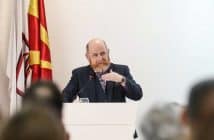The €8.5 million Blackrock Further Education Institute building, designed by Valerie Mulvin of McCullough Mulvin Architects, has been sensitively restored and conserved by encompassing three heritage buildings into one modern design.
The contract was awarded after a previous contractor went into liquidation and the project was reissued for public tender again. Collen Construction Ltd began works in July 2012 and completed in May 2014 after assembling their in-house team and selecting master crafts people for the extensive restoration works. This is a perfect example of a project that blends traditional heritage with modern design. The three existing protected structures from the 1860s – 1900s have been reordered, reorganised and upgraded to include senior institute facilities and a new library facility. While the existing buildings were restored and refurbished to accentuate the original features, the new building uses modern building techniques and is steel framed with block work infill, pre-cast concrete floors and in-situ concrete stairs. The completed building is a structure that manages to portray a seamless connection between old and new, whilst the finishes to the existing structure belies the amount of intensive restorative works completed.
Now complete, it’s one of the largest dedicated Further Education Institutes in the Dublin and Dún Laoghaire Education and Training Board, catering for over 1,000 full and part-time students. The original Carnegie Library has also been restored and conserved; it is now the new ‘Blackrock Library’. Existing features such as the original mosaic floors, cornices, arches and corbels have been retained and restored. Modern additions of a new mezzanine floor and a European oak entrance lobby screen create an expansive feel to the building complimenting the original lofty ceilings and archways. Rustic red brick chimney stacks are exposed and retained as a feature wall including the original clay piped chimney liners. The library boasts the modern additions of a new lift and sleek book shelving and state-of-the-art IT facilities throughout.
Derek McCaffrey, Contracts Manager at Collen Construction, worked on the project for the duration of the contract. “There were several interesting aspects within the project given the nature of its historical status but the first major challenge we faced was the restoration and reinstallation of a lantern roof light, which was originally positioned on another part of the building. Restoration of the lantern had been completed off site by DASK Timber who were involved with the project. The new location for the reinstallation of the roof lantern is over what is now the boardroom. This was a major challenge; not only did we have to replace the lantern roof but areas of the roofs on the building required complete restoration from the rafters to the existing chimneys and lead work. We were under pressure to get the lantern refit onto the roof in a very short amount of time which was adjacent to a live crèche campus.” The team had permission from the crèche to erect scaffolding for a certain amount of time only on their premises. “The entire parapet also had to be stripped and rebuilt
in the same timeframe but despite everything, this particular aspect of the project was completed on time. I think it was a positive experience for the team to have come up against such a major challenge at the outset as it demonstrated our intent to complete the works to the satisfaction of all parties. The fact that we maintained our agreements by meeting the deadline, retained a good relationship with the crèche owners and carried out a high standard of work was a good start to the build”.
The new modern structure is approximately 4,347m2 with 250m2 of atrium and garden space. Modern facilities in the new building include computer laboratories, design studios, beauty salons and an ICT learning centre. The atrium, where the old and new buildings meet, boasts floor covering that was specially sourced and digitally printed from a photograph that the architect Valerie Mulvin took at the local beach in Blackrock. Maintaining the link between old and new, the original fire station archway entrance has been preserved and incorporated into the new school building. To make sure the historical character of the arch was maintained, a small stone coursed random rubble side wall was built using old-fashioned building methods and techniques.
Before building work commenced all salvaged material from the old structure was taken to Collen’s storage yard in East Wall where it was sifted, sorted and tagged. This was the process for the entire build; as much as possible, everything was reused. “Almost all timber floors (57 floors) have been restored after being carefully removed off site, catalogued, measured and treated with a finish before being reinstalled. Existing slates were reused and when they were beyond repair, Barbary Construction, who did the roofing, sourced salvaged slates to match. Doors had to be upgraded to current fire regulations so they were taken off, restored and upgraded. All the chimneys were renovated, along with all the chimney pots. We then lead capped the whole thing along with the parapets to futureproof it for the next 100 years.” The team at Collen went above and beyond the brief’s remit when it came to the copper topped louvered timber tower, a historical and decorative feature of the structure. “The drawings specified that a sanded and painted finish should suffice but after we removed all the existing paint and sanded it down, we saw that an incorrect paint had been previously applied and soft wood louvers installed that where now damaged.” A pre weather copper was originally priced but Collen Construction felt this would look false and unnatural so a match was needed for the existing dome and spire. “We always strive to achieve a high quality finish on all of our projects and so we made the decision to pay additional costs to install natural copper to match the existing dome and spire. At the moment, the new copper is in its natural state but it’ll eventually patinate (weather) and match the existing tower.”
Derek McCaffrey and his team followed the architectural brief to the letter. Every small intricate detail had been carefully planned and thought through and overall there was a considered approach to the entire project which has ensured there’s no conflict between the old structure and the new, modern design. The hallways in particular demonstrate the old and the new buildings; in this location a hanging or ‘suspended’ ceiling has been specified and appears to float in mid-air. This demonstrates the link between the old stone and brick walls with the modern, with only a minimum amount of work to the walls to ensure they look just like they did decades ago. “The whole idea was that BFEI was given the building back with the existing fabric kept in place. For example some of the existing red bricks in the wall were patched with standard stock bricks over the years but they weren’t taken out as part of the restoration. We restored where required. That means that in parts we had to clean off the walls with minimum impact to the finish and sealed it. That was it.”
Original windows were taken out, repaired and reinstalled. New architraves were inserted only where required. Old fireplaces and old grilles have been left as they were and two very large king post trusses that were originally in the old chamber room have been retained as architectural historical features; one is in the atrium and the other is on a ramp in a transition area between old and new. The infrastructure and containment for mechanical and electrical services in the existing building have been incorporated into the building fabric. Piping, cabling and ventilation ducts have been cleverly hidden to protect the combined buildings historical status.
Building regulations stated a need for wider stairs in the area that leads to the new staff room. It was within the architectural brief to retain the original staircase. This presented a challenge for the team. “The design took a huge amount of coordination between MCM Horgan Lynch and ourselves to ensure it was going to work and on top of that, it was a very challenging technical problem in that we had to ensure the new additional stairs complimented the old section. The solution was a ‘hanging staircase’ which was effectively a new stair extension built on the side. This fitted onto the edge of the original stair case and then hung from the ceiling. It wasn’t easy to achieve but it worked out much to the approval and appreciation of the teachers”.
Six secret “Jib” doors are dotted around the new facility, replicating the secret doors that used to exist in the original structure and further maintaining the link between old and new. Every floorboard in the old structure is flooring that has been taken from the salvaged material which was stored off site in Collen Construction’s designated storage yard specifically leased for the scale of this project. “As many of the existing doors as possible were used but some were beyond salvage or didn’t suit the dimensions required. We weren’t able to use as much of the old ironmongery as we would have liked due to changed regulations, so where necessary we sourced and used bronze replicas.”
The new boardroom with the lantern roof on top is the ‘piece de resistance’, as described by Derek McCaffrey. All the original corbels and wainscot pannelling have been restored as well as original and replica cornices and all the original flooring. “When you stand here and look around, it’s nearly impossible to understand and easy to underestimate the amount of work that went into this room alone.” The other stand-out room (of which there are many) is the new library, a huge room that has been painstakingly restored. “Due to damage and water ingress we were faced with a roof that was bowed with rafters and ceiling finishes dipping down. This required the rafters and king post trusses being repaired insitu in order to retain as many of the original ceiling plasterwork and cornice finishes as possible. “Séamas Ó’hEocha Teoranta completed all the internal restoration. Again the whole project was very much a considerate restoration in that if we didn’t absolutely have to let go of something, we retained it within its original position and context.”
Refurbishment to the front facade of the building was extensive and included the cleaning and rebuilding of decorative plaster work which included cartouche’s swags, drops, pillar pilasters and window brackets. “The whole facade was repaired with specific types of mortar and lime renders. We retained what we could of all original features and replicated the rest.”
All of the work was completed using the same hand-carved traditional techniques that would have been used when the building was first constructed. Samples of sand where matched from beaches in Wexford, Donegal and Galway to find the perfect blend. The ornate shell feature positioned over the archway of the front entrance to the new Blackrock Library was handmade by Old Stone. “A clay model was produced for McCullough Mulvin Architects and on Valerie’s design approval it was created and installed from a remmers material which is a restoration mortar for external use. This careful attention to detail is demonstrated throughout the building. The shell is there to signify the proximity of the facility to Dublin Bay”. The old town clock is the original, renovated and restored with a new mechanism and new hands. “A lot of protection measures have been applied to the front of the building. The aim is that the facade and indeed the whole building will be protected for the next 100 years and still look as good.”





